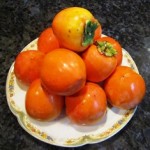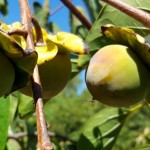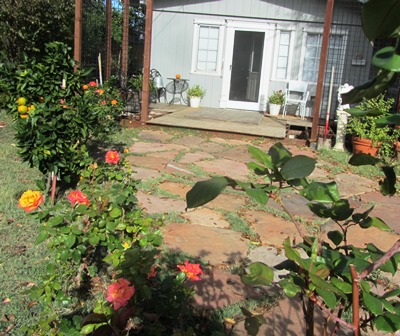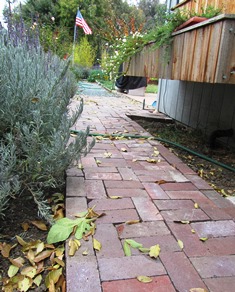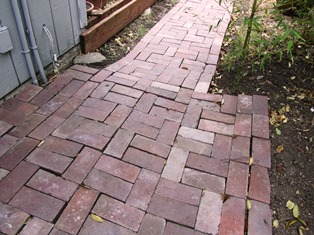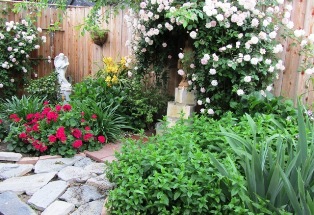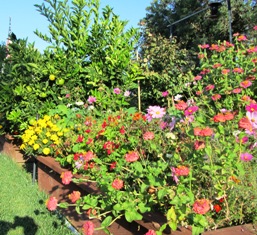Fruit Drop with Young Hachiya Persimmon Trees
My three-year-old Hachiya persimmon tree was loaded with fruit but recently went through a huge fruit drop. Possibly the long stretch of triple-digit summer heat coupled with the tree not getting enough water may have caused this problem. Young trees are more prone to fruit drop than trees that are mature.
I find the fruit drop disconcerting because Hachiyas are my favorite persimmons. It did the same thing last year.
Each autumn, I wait with anticipation watching the fruit and checking it often until October for ripeness. This fruit is highly astringent so must be eaten ripe. The fruit texture is like jelly with a sweet and slightly spicy flavor.
Besides the fruit, what I like about this persimmon is that it becomes a showstopper in the fall with red, gold, or yellow leaves. During winter, the fruit hangs on the tree like ornamentation.
The Hachiya trees are not much bothered by pests or disease. They require at least a half day’s sun and well drained soil. These trees grow to 15 to 20 feet tall. They make great landscape trees and the fruit is a wonderful bonus.
______________________________________________________
If you enjoy reading about growing fruit trees or heirloom plants or trying delicious recipes or keeping bees and chickens and you like a mysteries, check out my Henny Penny Farmette series of cozy mysteries from Kensington Publishing in NY. They’re available online and in traditional bookstores everywhere.

A HIVE OF HOMICIDES is the newest offering in the Henny Penny Farmette series; available Sept. 26, 2017
Currently, A HIVE OF HOMICIDES is a featured title in Barnes & Noble’s September promotional BUY 3, GET 1 FREE sale.
WHAT IS THE BUY 3, GET 1 FREE OFFER?
Everyone who buys a Kensington cozy mystery from the B&N in-store display or any Kensington cozy mystery from BarnesandNoble.com between 9/5/17 – 10/5/17 and registers their purchase at http://sites.kensingtonbooks.com/kensingtoncozies/BN/ will:
— Automatically be entered into Kensington’s “Cozy Mystery Bonanza” sweepstakes for a chance to win a $300 value gift basket. One grand prize winner will be selected after the sale has concluded.
— Automatically receive a free Kensington Cozies recipe booklet plus a download code for the novel A STORY TO KILL by Lynn Cahoon after the sale has concluded.
* * *
DON’T FORGET TO ENTER THE FREE DRAWING AT GOODREADS.COM.
Win a signed copy of A Hive of Homicides along with a gorgeous reversible apron and a set of 2 chicken napkin rings. Enter before September 26 for a chance to win.
See, https://www.goodreads.com/book/show/33911114-a-hive-of-homicides?from_search=true
Farmette Projects Don’t Stop, Even with the Rain
The rains have arrived in the Bay Area . . . finally. Although my hubby and I are thankful for the wet stuff, we weren’t quite ready.
Our sheds have leaky roofs. I also need to install a different kind of gate on my chicken run; one that won’t swell with moisture and get stuck so that I can’t open it. I close the gate at night against predators, but the chickens free range in the yard during the day.
Our supply of building materials is dwindling as we are completing some projects. Much of the stone and retaining wall materials, torn out from estates that are being re-landscaped, were donated to us. Carlos and I were only too glad to integrate them into our own landscape. We work on it little by little.
With mud everywhere, I probably appreciate more than anyone having the flagstone leading to the front door, however, we still need to fill the spaces between the flagstone with gravel.
We’ve built fences and put up the frame for an entrance trellis where the gate will go in. We also have constructed a porch trellis that I will grow wisteria over, but we have to install the porch floor first. We’re using plywood in the meantime.
The long half-circle driveway is packed dirt, although we have shoveled in gravel where my husband parks his truck. Now that the rains have arrived, the driveway is pretty muddy. We need to figure out whether we’ll put in gravel for entire length of the driveway (there’s some there now) or lay asphalt or stone.
So while it rains, I think about our master plan for the farmette. We’ve come a long way . . . but there’s still a huge distance to go and some projects can’t wait for spring like those leaky shed roofs.
The Benefits of Bamboo
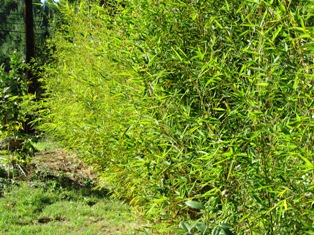
Bamboo plants make great screens, clipped hedges, or a dramatic foil for plants layered in front of it.
Bamboo plants are favored by environmentalists because they are drought tolerant, can be used for erosion control, are not fussy about soil, make fast-growing hedges or screens, and quickly naturalize.
We grow mainly the clumping type of bamboo because it makes very little horizontal growth and stays tightly clumped. It just gets dense.
The runner type, however, spreads through underground stems that grow out from the rhizome. These are the types of bamboos that reach considerable heights and form groves.
Dividing the plants helps maintain control of these woody-stemmed giant grasses.
Spring is the best time to divide bamboo plants. Although spring is still a few days away, we are dividing the bamboo that thrives along our farmette fences and planting it as a screen on the side of the house where we can see traffic from the road.
Although bamboo has gotten a bad rap for spreading into areas where it isn’t wanted, it can be confined in containers or by inserting metal or concrete barriers into the soil to prevent unwanted invasion by the runner type.
The plant’s evergreen leaves on tall, slender stems look graceful swaying in the breeze and, coupled with its other benefits, make bamboo a good choice for some landscapes.
Less Mopping, More Writing
It may not be immediately apparent what recycled bricks have to do with writing, but bear with me. A friend who does professional demolition of houses and properties brought us a truckload of bricks from an owner who was re-landscaping his upscale property in a nearby East Bay city. Otherwise, those bricks were destined to be discarded in a landfill.
Temperatures hovered near 70 degrees Fahrenheit this past weekend (Thanksgiving) and the weather was perfect for us to lay a brick walkway. My architect husband and I are passionate about recycling materials that still have life in them. It’s one of the reasons why two of our favorite places to visit are architectural salvage yards in Berkeley: Ohmega and Urban Ore. See http://www.ohmegasalvage.com/ and also see http://UrbanOre.com/
With the rainy season on its way, it seemed like a good idea to lay the brick in a pattern along the northwestern side of the house where we keep the recycle and garbage bins. During winter, we track a lot of mud into our small farmette home because we have only dirt and gravel paths through the garden and orchard areas.
This year, it will be different. The newly laid brick walkway runs from the front to the rear of the house, joining the front porch (that we are currently building) with a gravel path leading to the property line. We laid out the brick pattern and tapped them close together, using a rubber mallet (since hitting brick on brick can cause breakage).
We still need to pour sand on top and sweep it into the cracks. But this kind of path can last for years. The ancient Romans built similar paths that remain to this day. The rains will come, but less mud will be tracked in because of the paving stones. That means for me fewer hours this winter spent mopping the mud tracked in and more time writing on my cozy mystery series.
Gardens as Sacred Space
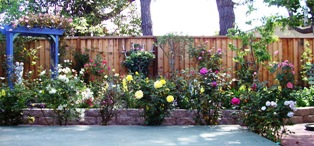
Painted with the French words for peace, love, and prayer, the blue trellis serves as a garden focal point
In seed time learn, in harvest teach, in winter enjoy.–William Blake
It feels like winter. No sun after a clear, cold night. The temperature at Lake Tahoe this morning was a level zero. Here on the farmette, the temperature is having trouble pushing out of the 40s. Though bleak outside, there is light and warmth in our little farmhouse. Soup gurgles in the pot on the back burner, and the seed catalogs are close at hand.
Remembering visionary poet William Blake’s admonishment to enjoy winter, I’m trying. The seed catalogs remind me of plants and gardens of my past, the great gardens of the world, and the secret places that all gardens hold–places awaiting discovery or re-discovery. Places that create magic in a garden.
My garden isn’t just a place to cultivate plants; it exists as sacred space, a tranquil retreat. There under trees and amid the roses that I invariably plant, my restless spirit knows its place and can find its peace.
Gardens are so much more than trees and flowers, chimes, statuary, benches, and fountains of flowing water. Far more important than what is visible in a garden is what is not seen . . . but felt.
A garden is a place of presence. One of my favorite writers John O’donohue, Anam Cara and Eternal Echoes) observed, “that presence is alive.” Sacred space beckons us to step away from the cacophony of the world and enter Kairos or God’s time to dream, create, pray, love, nuture Self, and experience the wild presences of Nature.
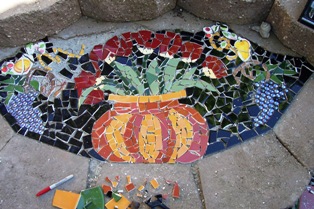
The best gardens always have a little surprise; this is a garden step I created some years ago while writing my Adventures in Mosaic book
We step in and out of the garden, a living and ever-changing landscape, but it is only when we linger in the landscape that we are embraced by the unseen–what O’Donohue referred to as silent and indirect presences.
A garden nourishes and nurtures. It was to the garden I turned after losing five family members in five years; my mother and my 46-year-old husband were the last to go. I hid myself away in our garden, turned on the water, and allowed my own tears to flow until none were left.
Later, I spent hours in the garden, mourning my loss, remembering my dreams, re-imaging my future, and praying for my aching heart to heal. Relief came as I created pique assiette mosaics and photographed them for a book to be published.
From broken china pieces and colored glass, I created a child’s tea table. When a local teacher told me about a girl in her class whose father needed a heart transplant and had no money for Christmas presents, I gave the table to his little girl.
In my garden, I found healing and wholeness and strength to again step into life. The power of sacred space can do that. It can uplift your spirit and nourish you with light and warmth when all seems so terribly bleak. Best of all, garden memories are bearers of light and joy, nourishing your spirit even on the darkest, coldest days of winter.
Boxes To Grow Just about Anything
When we arrived at the Henny Penny Farmette our first summer here, the weeds on the property towered over our heads. We knew it would take a lot of work to change the wild, chaotic landscape into something beautiful. After we pulled more weeds than we ever want to remember, we planted a garden, started a bed of herbs, and (during the following bare root season in late January) put in an orchard. That rainy season we had 21 straight days of rain.
My husband Carlos had left to visit his family in the Dominican Republic. The rains didn’t let up. I feared the septic would overflow, take down the young trees, and destroy our herb beds. Near the end of that rainy period, the water level rose high enough to threaten the door into the house. Then the rain stopped.
When Carlos returned, he hired some workers to help us reconfigure the landscape, move dirt, and create a level backyard. We put in a small lawn and gravel paths that defined the entire space at the back of our property. We also raised one area of the yard where the septic could drain in a different direction than the house if it rained like that again.
Carlos incorporated into the overall landscape design several planting boxes in which to grow our berries as well as flowers. The soil here is heavy clay that turns to concrete in the summer. Planting boxes allows us to control the soil, enriching it with nutrients and compost as needed. The gravel paths enable us to move around the acreage during the rainy season, inspecting the boxes of plants, without getting getting mired in mud. The cost to build each box is about $125.00.
Planting boxes allow us to meet each each plant’s needs, for example, acid-soil for blueberries, or great drainage for roses. I first observed raised beds in massive planting boxes during a trip to Russia in the late 1990s. In a centuries-old village along the Volga, I saw vegetables and herbs flourishing under an apple tree planted in the center of a massive box. Our Henny Penny Farmette planting boxes are 4 ft. by 6 ft., so we wouldn’t grow trees in the boxes. However, we have planted a citrus or fruit tree between the boxes. These raised beds in frames truly make it possible to grow almost anything and create a sense of order out of the wild chaos of nature.
 Facebook
Facebook Goodreads
Goodreads LinkedIn
LinkedIn Meera Lester
Meera Lester Twitter
Twitter




